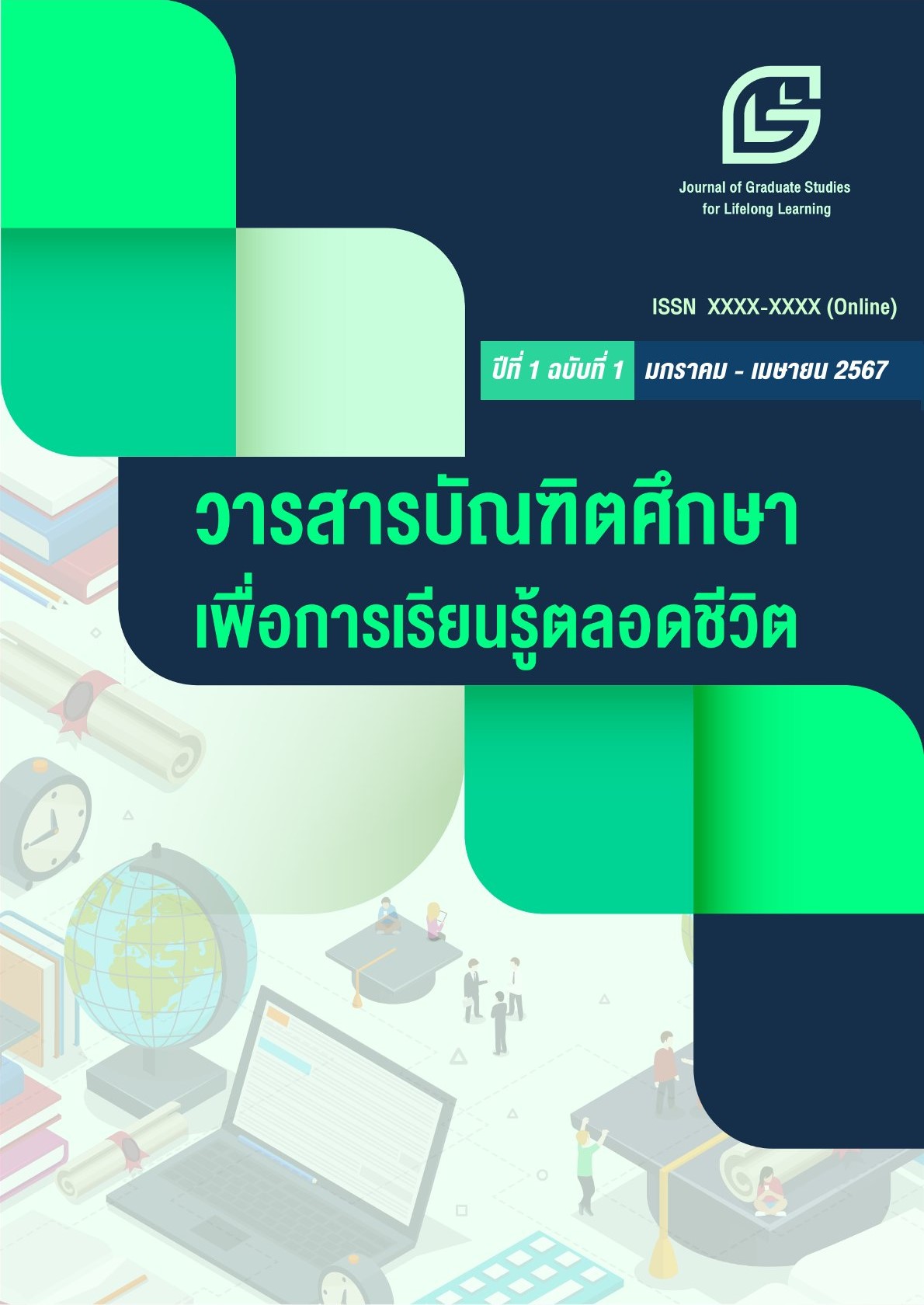Developing a Creative Thai Language Curriculum to Promote Constructive Criticism for High School Students
Main Article Content
Abstract
The objectives of this research are to 1) develop a creative Thai language curriculum to promote constructive criticism for high school students and 2) study the effectiveness of a creative Thai language curriculum to promote constructive criticism for high school students.
Conduct research according to the research and development process. Using mixed methods. Using a sample group, there are 99 students in Mathayom 5 at Kowithamrong Chiang Mai School, semester 1, academic year 2023, obtained from cluster random sampling. The research tools included 1) a creative Thai language curriculum, 2) lesson plans, 3) a constructive criticism test, 4) a questionnaire on students' opinions on learning management according to the curriculum, and 5) t-test. Statistics used in data analysis include mean, standard deviation, and t-test.
The results of the research found that the developed curriculum has 5 components: 1) principles; 2) objectives; 3) curriculum structure and content framework; 4) process of organizing learning activities; and 5) measurement and evaluation. The quality of those components are assessed with the highest level. The curriculum's effectiveness was evaluated, and it was found that after the trial, students provided more constructive criticism than before studying, with a statistical significance of 0.05. It is determined that opinions regarding the organization of learning are based on the curriculum at the highest level. It can be seen that the curriculum is an innovation that is suitable for promoting students in the 21st century in a concrete way.
Article Details

This work is licensed under a Creative Commons Attribution-NonCommercial-NoDerivatives 4.0 International License.
References
สำนักงานวิชาการ, กระทรวงศึกษาธิการ. (2566). ตัวชี้วัดระหว่างทางและตัวชี้วัดปลายทาง ตามหลักสูตรแกนกลางการศึกษาขั้นพื้นฐานพุทธศักราช 2551 และแนวทางการวัดและประเมินผลการเรียนรู้ตัวชี้วัดระหว่างทาง ตัวชี้วัดปลายทาง และเกณฑ์การตัดสินผลการเรียน. กระทรวงศึกษาธิการ.
ธิติ ธีระเธียร. (2564, มกราคม 28). Hard Skills + Soft Skills และ 7 เทรนด์การเรียนรู้เพื่อการศึกษาในยุคเทคโนโลยีเปลี่ยนโลก. STARFISHLABZ, https://www.starfishlabz.com/blog/48-hard-skills-soft-skills.
นภาศิริ ฤกษนันทน์, มารุต พัฒผล และดนุลดา จามจุรี. (2565). การพัฒนารูปแบบการจัดการเรียนรู้เพื่อเสริมสร้างทักษะการคิดซับซ้อน สำหรับนักเรียนระดับมัธยมศึกษาตอนต้น โรงเรียนสาธิตสังกัดมหาวิทยาลัยศรีนครินทรวิโรฒ. วารสารศิลปการจัดการ, 6(3), 1048-1063.
นิภาพร กุลสมบูรณ์ และสุวิมล ว่องวาณิชย์. (2565). Active Learning: จากความเข้าใจที่คลาดเคลื่อนสู่ปรัชญาและทฤษฎีรากฐาน ตั้งทิศให้ถูก เพื่อไม่ทิ้งครูให้หลงทางอีกต่อไป. วารสารคุรุสภาวิทยาจารย์, 3(2), 1-17.
พีชาณิกา เพชรสังข์. (2565). การพัฒนาหลักสูตรเสริมสร้างความสามารถในการออกแบบกิจกรรมการเรียนการสอนที่ผสมผสานเทคโนโลยีตามแนวคิดการจัดการเรียนรู้แบบเน้นประสบการณ์และการเรียนรู้แบบผสมผสานสำหรับนักศึกษาระดับปริญญาตรี. วารสารวิชาการมหาวิทยาลัยราชภัฏเพชรบุรี, 12(2), 4-13.
มารุต พัฒผล. (2567). การวิจัยและพัฒนาเพื่อการพัฒนาหลักสูตร. ศูนย์ผู้นำนวัตกรรมหลักสูตรและการเรียนรู้.
วิชัย วงศ์ใหญ่ และมารุต พัฒผล. (2567). การเรียนรู้เชิงสร้างสรรค์. จรัลสนิทวงศ์การพิมพ์.
เวิน ริทัศน์โส, อุษา ปราบหงษ์ และสำราญ กำจัดภัย. (2565). การพัฒนาหลักสูตรบูรณาการตามแนวคิดสะเต็มศึกษาและทฤษฎีการสร้างสรรค์ด้วยปัญญา เพื่อเสริมสร้างทักษะการเรียนรู้และนวัตกรรมของนักเรียน สำหรับนักเรียนชั้นประถมศึกษาปีที่ 6. วารสารวิชาการและวิจัยทางสังคมศาสตร์, 17(3), 129-142.
ศิริวรรณ วณิชวัฒนวรชัย. (2566). วิธีสอนสมัยใหม่. คณะศึกษาศาสตร์ มหาวิทยาลัยศิลปากร.
อาทิตย์ ซาวคำ และศิริวรรณ วณิชวัฒนวรชัย. (2566). วิธีการสอนภาษาไทยเชิงสร้างสรรค์เพื่อส่งเสริมผู้เรียนในฐานะพลเมืองแห่งศตวรรษที่ 21. วารสารครุศาสตร์ ราชภัฏเชียงใหม่, 2(2), 1-8.
อาทิตย์ ซาวคำ และศิริวรรณ วณิชวัฒนวรชัย. (2566). นวัตกรรมการเรียนรู้วรรณคดีเชิงสร้างสรรค์ เพื่อส่งเสริมการคิดอย่างมีวิจารณญาณสำหรับผู้เรียนระดับชั้นมัธยมศึกษาตอนปลาย. วารสารครุศาสตร์ ราชภัฏเชียงใหม่, 2(3), 15-30.
Cambridge International Education Teaching and Learning Team. (n.d.). Getting Start with Active Learning. Cambridge Assessment International Education, https://www.cambridge-community.org.uk/professional-development/gswal/index.html.
CBE Thailand. (n.d.). Higher Order Thinking (HOT) competency. https://shorturl.asia/X1iWG.
Creswell, J. W., & Plano Clark, V.L. (2011). Designing and Conducting Mixed Methods Research (2nd ed.). Sage Publications.
Disruptignite. (n.d.). Education 2030 - The future of education in the next 10 years. https://www.disruptignite.com/blog/education2030.
Starfish Academy. (n.d.). What is Constructive Criticism? Why do children need to know?. STARFISHLABZ, https://www.starfishlabz.com/blog/176-constructive-criticism-.
Stringer, H. (2021, October 1). Constructive criticism that works. AMERICAN PSYCHOLOGICAL ASSOCIATION, https://www.apa.org/monitor/2021/10/career-constructive-criticism.


